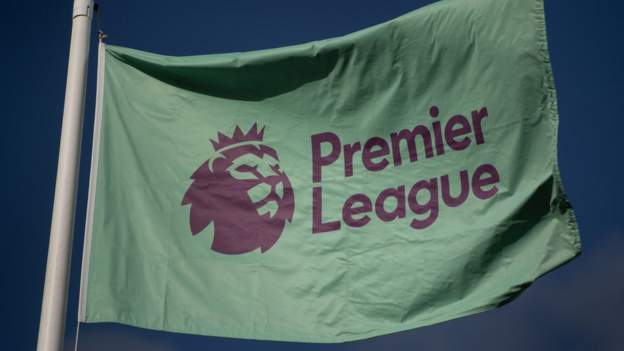[ad_1]

The Premier League established itself as the leader in the European football market in the 2021-22 season, an annual financial report by Deloitte has shown.
The English top tier’s aggregate revenue of £5.5bn in 2021-22 was nearly double that of Spain’s La Liga.
The return of crowds to stadiums after the Covid-19 pandemic helped to grow revenues by 10% across Europe.
However, a 15% increase in wage costs across the ‘big five’ leagues caused a loss in operational profits.
“Topline figures show that European football has emerged resiliently from its most challenging period to date,” said Tim Bridge, a lead partner in Deloitte’s Sports Business Group.
“Following the lifting of Covid-19 restrictions, fans’ pent-up demand gave rise to record matchday and commercial revenues across Europe.”
Premier League establishes itself as market leader
Top-flight clubs in England reported a 12% rise in overall revenues during the 2021-22 season to a record aggregate revenue of 6.4bn euros (£5.5bn).
Matchday revenue in the Premier League totalled £763m – a £732m increase from the 2020-21 season, when the football was played, for the most part, behind closed doors.
Following the full re-opening of football stadiums in August 2021, the average attendance reached an all-time high of 39,950 across the course of the season, which helped to surpass pre-pandemic matchday revenue levels of £684m from the 2018-19 campaign.
Deloitte put the Premier League’s commercial revenue reaching a new high of £1.7bn down to fans’ renewed appetite for football after the pandemic.
Bridge said international interest was continuing to drive the Premier League’s revenue growth but warned that “sustainable operating, funding models and acting with integrity” needed to be at the top of stakeholders’ minds to ensure the league’s “longevity and ultimate success”.
Despite seven Premier League sides reporting a reduction in wages, the overall wage costs – which covers playing and non-playing staff – increased by 6% to £192m, rising for a second year running.
Wage increases remain outpaced by revenue growth but, with a £395m rise in operating expenses, clubs’ operational profit – which excludes player transfer funds – in the 2021-22 season was down £1m from the previous year to £459m.
However, the takeover of both Newcastle United and Chelsea by new owners helped to lower Premier League clubs’ net debt by 34% from £4.1bn to £2.7bn.
How do the big five compare?
La Liga’s revenues, despite a total increase of 11% to 3.3bn euros (£2.8bn) in the 2021-22 season, remain half that of the Premier League.
Again, the relaxation of Covid-19 restrictions was the main reason behind the revenue increases seen across Europe, with Spanish top-tier clubs generating 409m euros (£349m) of matchday revenue, a 353m euro (£302m) increase from 2019-20.
Germany’s Bundesliga was disrupted mid-season when Covid measures were reintroduced for a period, but the league’s revenue increased by 5% to reach 3.1bn euros (£2.6bn).
Meanwhile, Ligue 1 clubs in France experienced the greatest percentage growth in aggregate revenues – a 26% rise from 412m euros (£353m) to a record high of 2bn euros (£1.7bn).
Italy’s Serie A was the only big-five league to record a fall in aggregate revenues, with total revenue decreasing by 7% to 2.4bn euros (£2.1bn) due to a fall in value of domestic and international broadcast deals.
Deloitte’s Bridge said the introduction of Uefa’s latest financial sustainability regulations, which will limit clubs’ spending on wages, transfers and agents’ fees, had placed European clubs at a crossroads between “the most pivotal regulatory changes that the game has ever seen and a wave of investment into global football in an attempt to challenge the established system”.
“With emerging leagues looking to grow their offering and secure the best in on-pitch talent, European clubs’ future may be dependent on how sound their financial foundation will be and whether they can use that to remain competitive and relevant,” Bridge added.
Championship clubs net debt ‘significant’
The Championship, League One and League Two’s combined revenue was more than £1bn in the 2021-22 season.
England’s second tier had an 13% increase in revenue to £676m, League One’s rose by 71% to £220m, while there was a 32% rise to £124m in League Two.
Despite wage costs falling for a second consecutive year in 2021-22, wages in the Championship remain higher than the revenue earned with a wage-revenue ratio of 108%.
Championship clubs’ net debt in 2021-22 was £1.7bn, which Bridge called “significant” and said “long-term decisions” needed to be made to combat the “glamour of Premier League promotion” which drives Championship clubs to “overstretch financially”.


[ad_2]
Source link




